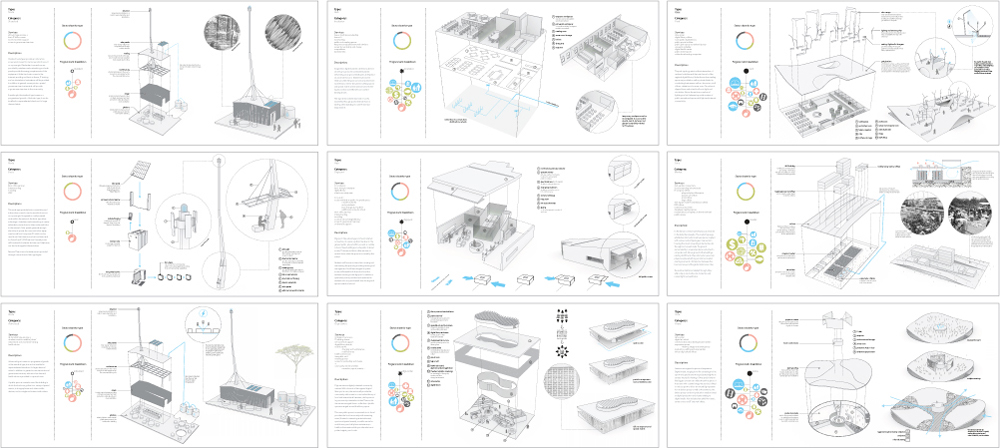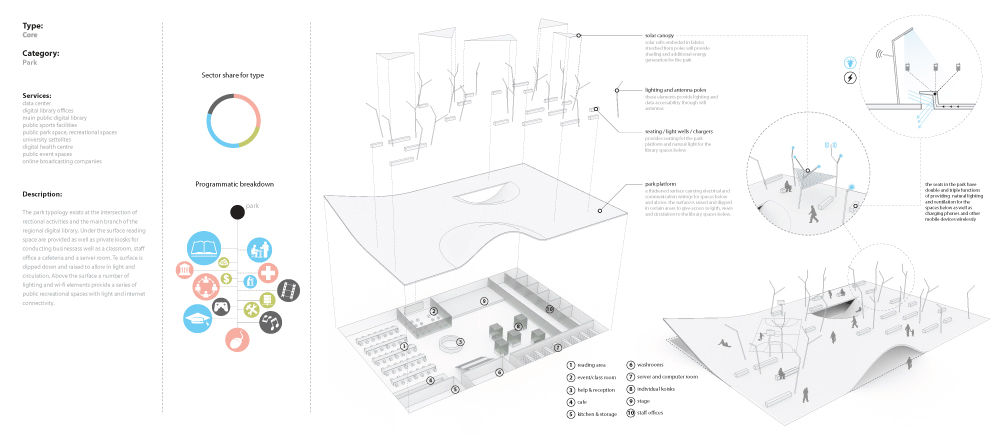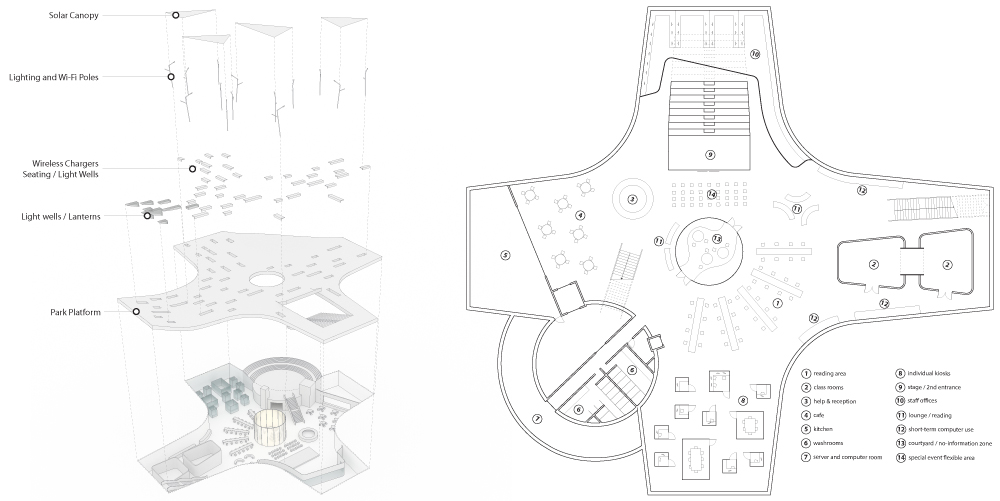Infostructures
New Spatial Typologies for an Emerging Information Economy
The rampant diffusion of Information and Communication Technologies (ICTs) has been a defining factor of 20th and early 21st centuries. The Internet and its networks of distribution have become the backbones for commerce, media, education, and research. The ubiquity of mobile devices, such as mobile phones and laptops, has extended our connectivity to coffee shops, parks and other public spaces. Yet, our fascination with the seemingly immaterial and virtual characteristics of information technologies has prevented deeper research into the physical geography of information networks. The prevalent reading of digital networks as the 'always-on, always-accessible network' tends to ignore a set of power relations, which have resulted in a polarization of information distribution. The submarine communication cables that connect continents to each other have largely followed the telegraph lines of early 20th century, hence establishing poles of high and low information connectivity. These cables are the not-so-visible proof of our dependence on concentrated sources of information. These very real and physical 'communication highways' establish links between information super hubs, while controlling Internet’s dissemination of information.
As access to information becomes a common and increasingly necessary feature of cities around the world, developing countries and emerging economies have begun to acknowledge ICTs as important factors for development. This has given way to a rush towards securing 'info-resources'. The recent landing of multiple submarine cables at Africa's coasts is testament to this push for connectivity. Developing countries of Africa see ICTs as agents for development.
![Global network of information vs. hunger, education, oil production and arable lands]() The African Condition
The African Condition
There are two major trends in Africa's move towards ICTs. One is the proliferation of mobile use within the continent by the general public and businesses alike, and the second is the establishment of technology clusters aimed at attracting the larger IT businesses such as Business Process Outsourcing and software companies. Although mobile communication and its proliferation in Africa has been the topic of numerous and varied discussions, the full effects of technology clusterization in African cities are still to be studied.
Technology Clusterization
As cities of the developing world vie for entry into the global information market, highly engineered spaces of data efficiency are inserted within contexts which until recently were ignored by not only information networks but also other infrastructural developments. Due to heavy dependence of information technologies on more traditional infrastructure such as power, water and transportation, introduction of information infrastructure in developing countries is usually manifested through establishment of IT parks (Knowledge parks, Internet villages, Technology campuses). Typologically, the local performance of such parks is limited. Devised as hyper connected enclaves fitted with walls, security fences, armed guards and defensive urban design, these 'info-bubbles' attempt to bypass the barriers and constraints of local geography, by systematically ignoring the local condition, while aligning themselves with global flows of information and economy. The current investment of Kenya, Uganda, and Nigeria, among other African countries, in developing IT clusters indicates both the enormous potential for ICT growth in the region, as well as the lack of a future-oriented plan for public engagement as part of a more widespread information economy. This clusterization will result in further polarization of access to information networks and a deepening of the digital divide already prevalent in most of these contexts.
![Regional information distribution plan: Lagos-Mombasa Corridor]() Infostructures
Infostructures
Infostructures presents an alternative to the clustering of information technologies in IT parks by envisioning a new breed of public spaces to address the formal and informal possibilities of insertion of high technology within the unique urban context of African cities. The stretch from Lagos, in Nigeria, to Mombasa, in Kenya, is chosen for a regional investigation. This decision is based on three conditions: First, the tremendous interest and investment of the region in entering the global information race, second, the growing young English-speaking urban population, and third, the recent connections made to the global information network by Nigeria and Kenya.
![]()
![Matrix of building typologies]()
![One of the nine building typologies]() Inspired and influenced by existing digital network typologies, which provide models for scalable networking of localities, a regional distribution plan is established for the Lagos-Mombasa Corridor. Three major types of information spaces (Cores, Hubs, and Nodes) are introduced, each dealing with a specific type of activity, from data-heavy regional centers to rural access points. A matrix of building typologies further breaks down the three major types into nine typologies (Cores: Market, Park, Arena; Hubs: Digicenter, Digiport, Incubator; Nodes: Basic, Standard, Advanced). By incorporating specific sets of inputs and outputs (digital consumption and production), each of these typologies, ranging in scale from wireless access poles in rural areas to large urban markets in city centers, use ICTs to make digital information accessible to a wider segment of population. In addition to providing access to information, these networked spatial constructs incorporate renewable energy production, environmental management systems (such as rain-water collection), educational digital workshops, and workspaces for e-commerce. When we consider the requirements of access to information technologies, such as electricity, education and places for maintenance, a new spatial economy emerges which is as much a product of the local condition as it is the product of the technology.
Inspired and influenced by existing digital network typologies, which provide models for scalable networking of localities, a regional distribution plan is established for the Lagos-Mombasa Corridor. Three major types of information spaces (Cores, Hubs, and Nodes) are introduced, each dealing with a specific type of activity, from data-heavy regional centers to rural access points. A matrix of building typologies further breaks down the three major types into nine typologies (Cores: Market, Park, Arena; Hubs: Digicenter, Digiport, Incubator; Nodes: Basic, Standard, Advanced). By incorporating specific sets of inputs and outputs (digital consumption and production), each of these typologies, ranging in scale from wireless access poles in rural areas to large urban markets in city centers, use ICTs to make digital information accessible to a wider segment of population. In addition to providing access to information, these networked spatial constructs incorporate renewable energy production, environmental management systems (such as rain-water collection), educational digital workshops, and workspaces for e-commerce. When we consider the requirements of access to information technologies, such as electricity, education and places for maintenance, a new spatial economy emerges which is as much a product of the local condition as it is the product of the technology.
![NDL bird's eye view]() Case Study: Nairobi Digital Library (NDL)
Case Study: Nairobi Digital Library (NDL)
Imagined as the main branch of a regional digital library, NDL's strategic location on the main fibre line, and its proximity to the University of Nairobi, the National Theatre, the National Museum, and a major broadcasting company, brings together a set of activities from research and education to entertainment and communication. NDL will house a small data center, reading areas, private booths, and other forms of access to information, from local literature to global news and market information. Above, a digital park is developed to provide free public Wi-Fi and access to the digital library archives, as well as charging stations for mobile devices such as cell phones and laptop computers, powered by a number of solar canopies. A data-free courtyard in the center of the building provides for breaks from the sometimes-overwhelming world of information flows.
![Plan and exploded diagram of NDL]()
![NDL top level]()
![NDL interior]()
As access to information becomes a common and increasingly necessary feature of cities around the world, developing countries and emerging economies have begun to acknowledge ICTs as important factors for development. This has given way to a rush towards securing 'info-resources'. The recent landing of multiple submarine cables at Africa's coasts is testament to this push for connectivity. Developing countries of Africa see ICTs as agents for development.

There are two major trends in Africa's move towards ICTs. One is the proliferation of mobile use within the continent by the general public and businesses alike, and the second is the establishment of technology clusters aimed at attracting the larger IT businesses such as Business Process Outsourcing and software companies. Although mobile communication and its proliferation in Africa has been the topic of numerous and varied discussions, the full effects of technology clusterization in African cities are still to be studied.
Technology Clusterization
As cities of the developing world vie for entry into the global information market, highly engineered spaces of data efficiency are inserted within contexts which until recently were ignored by not only information networks but also other infrastructural developments. Due to heavy dependence of information technologies on more traditional infrastructure such as power, water and transportation, introduction of information infrastructure in developing countries is usually manifested through establishment of IT parks (Knowledge parks, Internet villages, Technology campuses). Typologically, the local performance of such parks is limited. Devised as hyper connected enclaves fitted with walls, security fences, armed guards and defensive urban design, these 'info-bubbles' attempt to bypass the barriers and constraints of local geography, by systematically ignoring the local condition, while aligning themselves with global flows of information and economy. The current investment of Kenya, Uganda, and Nigeria, among other African countries, in developing IT clusters indicates both the enormous potential for ICT growth in the region, as well as the lack of a future-oriented plan for public engagement as part of a more widespread information economy. This clusterization will result in further polarization of access to information networks and a deepening of the digital divide already prevalent in most of these contexts.

Infostructures presents an alternative to the clustering of information technologies in IT parks by envisioning a new breed of public spaces to address the formal and informal possibilities of insertion of high technology within the unique urban context of African cities. The stretch from Lagos, in Nigeria, to Mombasa, in Kenya, is chosen for a regional investigation. This decision is based on three conditions: First, the tremendous interest and investment of the region in entering the global information race, second, the growing young English-speaking urban population, and third, the recent connections made to the global information network by Nigeria and Kenya.




Imagined as the main branch of a regional digital library, NDL's strategic location on the main fibre line, and its proximity to the University of Nairobi, the National Theatre, the National Museum, and a major broadcasting company, brings together a set of activities from research and education to entertainment and communication. NDL will house a small data center, reading areas, private booths, and other forms of access to information, from local literature to global news and market information. Above, a digital park is developed to provide free public Wi-Fi and access to the digital library archives, as well as charging stations for mobile devices such as cell phones and laptop computers, powered by a number of solar canopies. A data-free courtyard in the center of the building provides for breaks from the sometimes-overwhelming world of information flows.


